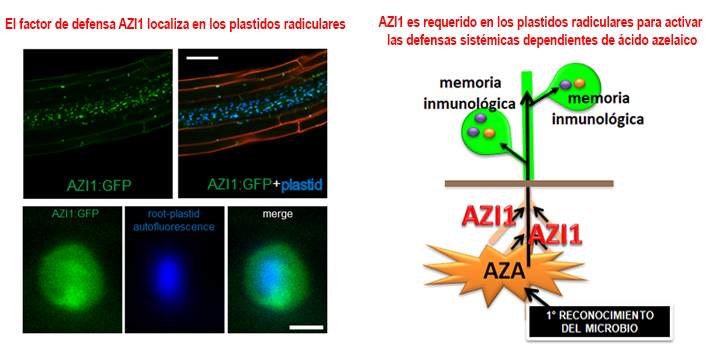Cecchini NM et al. J. Mol Plant Microbe Interact. 2018
Local interactions between individual plant organs and diverse microorganisms can lead to whole plant immunity via the mobilization of defense signals. One such signal is the plastid lipid-derived oxylipin azelaic acid (AZA). Arabidopsis lacking AZI1 or EARLI1, related lipid transfer family proteins, exhibit reduced AZA transport among leaves and cannot mount systemic immunity. AZA has been detected in roots as well as leaves. Therefore, the present study addresses the effects on plants of AZA application to roots. AZA but not the structurally related suberic acid inhibits root growth when directly in contact with roots. Treatment of roots with AZA also induces resistance to Pseudomonas syringae in aerial tissues. These effects of AZA on root growth and disease resistance depend, at least partially, on AZI1 and EARLI1. AZI1 in roots localizes to plastids, similar to its known location in leaves. Interestingly, kinases previously shown to modify AZI1 in vitro, MPK3 and MPK6, are also needed for AZA-induced root-growth inhibition and aboveground immunity. Finally, deuterium-labeled AZA applied to the roots does not move to aerial tissues. Thus, AZA application to roots triggers systemic immunity through an AZI1/EARLI1/MPK3/MPK6-dependent pathway and AZA effects may involve one or more additional mobile signals.
Autores: Cecchini NM, Roychoudhry S, Speed DJ, Steffes K, Tambe A, Zodrow K, Konstantinoff K, Jung HW, Engle N, Tschaplinski TJ, Greenberg.
Artículo: Underground azelaic acid-conferred resistance to Pseudomonas syringae in Arabidopsis. J. Mol Plant Microbe Interact. 2018 Aug 29. doi: 10.1094/MPMI-07-18-0185-R.



